
Create an Amazon Wedding Registry

Netherlands Infantry Uniforms
Here is a collection of various paintings and prints of Dutch foot soldiers. Most images are, unfortunately, after 1815, they nevertheless give a good picture of the appearance of the Dutch infantryman in the aftermath of the Napoleonic era. Click image to enlarge.
|
|
Entry of the 8th Battalion Line Infantry (formerly 2nd Battalion Orange Legion) into Deventer, April 26, 1814. As this picture shows, this battalion was dressed in British uniforms (red with white or blue lace and collar), "stovepipe" shako, gray trousers and black gaiters, painted canvas knapsack, while the officers were already dressed as prescribed, ie dark blue with rose distinctions and French model shako.
|
|
|
|
A sketch of Baron Jean Victor de Constant Rebecque, during the 1815 campaign chief of staff of I Corps under Prince William, he sketched the designs for a staff uniform in 1814. Clearly the low shako of the later 1815 model can be seen, but with the tight pants and half hight gaiters of the 1814 uniform. Note that on the right he drew designs for an epaulet. |

|
Officer, right flank company of Infantry Battalion No. 12 or 13, in the uniform of 1813 to 1814.
|
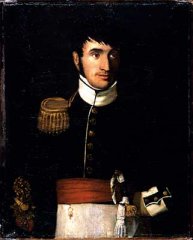
|
Portrait of Captain Joseph-Denis-Gilles Godenne, Southern Dutch Line Infantry Battalion No. 2, later renumbered No. 3, 1815. According to a report in the newspaper "l'Oracle", the first southern Dutch infantrerie officers in January 1815 in the new uniform, a few days after the release of the new rules.
|
||
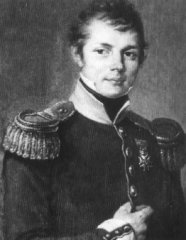
|
Portrait of an unknown colonel of infantry, 1815. The collar is still open. On his chest he wears the distinction of the "Legion d'Honneur". French titles and insignia given in previous years were authorized for the officers so as not to offend. (Note: Chasse also retained his French title of baron and his Legion d'Honneur.)
|
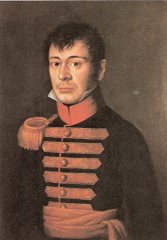
|
Portrait of Joseph Uttinger, captain in Swiss Regiment No. 32, 1815.
|
||
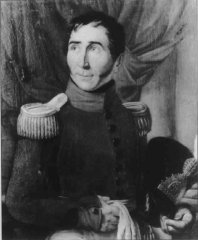
|
Portrait of an unknown lieutenant colonel of the National Guard, 1815. Note the fly closure of the cuff.
|
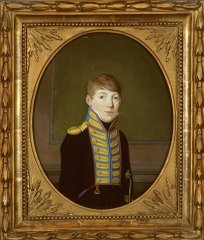
|
Abraham Johannes Vonk (1801-1818), cadet-flanker 19th East Indian Infantry Battalion, portrait from 1817. Until 1820 these uniforms had open collars and lace chest loops. Also he wears a distinctive contra-epaulette and an ornamental sword. Noteworthy here are the dark blue trousers.
|
||
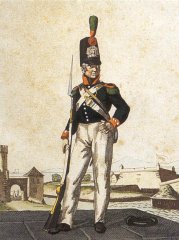
|
Flanker of a National Militia battalion, print by Genty, made during the occupation of Paris (July 1815). The green and red epaulettes and plumes were stolen from a French magazine. On the British leatherwork, the plate is replaced by a buckle and has a large joint attached. Again, the bayonet belt is worn under the cartridge pouch belt.
|

|
Drummer of the National Guard, 1815: Field blue cap with orange piping and band, the skirt has an open collar and blue cuffs with orange piping, closing with two buttons; wings with orange decorations, white swallow nests with white decorations.
|
||
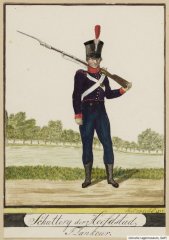
|
Flanker of the guard militia of the capital [Amsterdam], October 29, 1817. French model shako without plate, with red pompom over a roundel with large white loop with white metal button, British model coat with round cuffs and white buttons, dark blue 'closed' trousers with black half-gaiters, British leatherwork with "W" plate. It seems the musket is a French dragoon model.
|
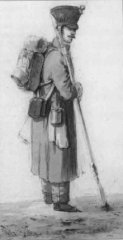
|
A Nassau infantryman in marching order, 1815, ink drawing by Langendijk. Although a German unit in Dutch service, the uniform looks much like that of the Dutch infantry. Especially during the campaign of 1815, the Dutch infantry 'on the march' being not much different.
|
||
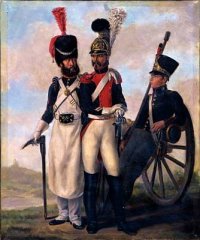
|
Three southern Dutch soldiers, namely a sapper in the infantry, a carabinier of the Carabinier Regiment No. 2 and a gunner, 1815. The sapper has a white catch cord and a red plume on his busby. The gunner already has the crown shaped plate, but no wings.
|
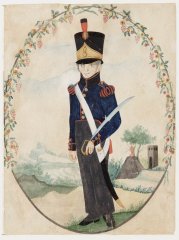
|
A touchingly naive (self?) portrait of a gunner, 1815. The decoration on the wings does not run onto the tongue of the epaulet. Clearly the shape of the blade of the sabre is a model No. 1 1815.
|
||
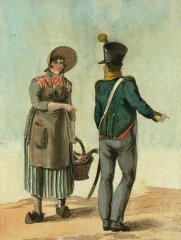
|
Langendijk signed in 1816 a series of single prints, with every picture being of a soldier and a Dutch lady. The following prints are from this range.
A Jager-Flanker and a fishwife: wings with red ornaments and yellow-green plume on the French model shako instead of yellow-green pompon.
|
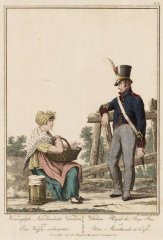
|
A corporal of the veterans (Garrison Battalion No. 34) and a coffee seller. The chevrons are the right model, but appear to be made directly on the sleeves. This may be because the collar, cuffs, epaulettes, are too dark, and therefore the backing has to be dark blue as prescribed.
|
||
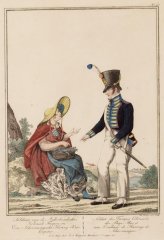
|
An infantryman of the Colonial troops of the East Indies and a fishwife of Scheveningen. The tunic had chest lace and loops. Interestingly enough, the uniform is almost identical to that of the punishment battalion. The shako has no rear peak, but metal chin straps ("jugulaires"). See also the portrait of Johannes Abraham Vonk.
|
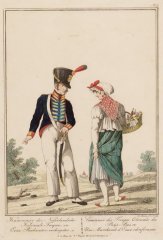
|
A Colonial gunner and a perfume seller. The uniform is different from that of the colonial infantry by the red collar, lace and pompom. Clearly visible is the No. 1 sabre and the shako plate.
|
||
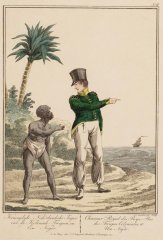
|
A jager of the colonial troops in the West Indies and a negro. Apart from the colour of the coat, dark green, it seeems the uniform on this print is very similar to the uniform of our depiction. On the shako is a Hunting Horn that all jager battalions had instead of the shako plate. Remarkably, it is missing a pom-pom. The trousers are wide, have a narrow flap, and gaiters are worn. | 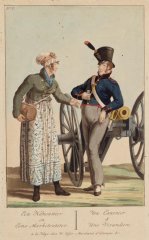
|
A gunner and a camp follower. The gunner wears here the 'W'-plate, as well as British leatherwork with coupling plate for the No. 1 sabre.
|
||
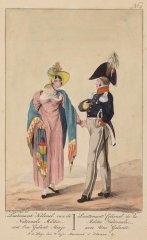
|
Infantry Battalions of the National Guard wore uniforms that were almost identical to that of the infantry, but the colour of the collar, cuffs and piping was orange, the epaulettes white, the cuff was round and did not have a fly. It was also possible, as the following pictures show:
A lieutenant-colonel of a National Guard Infantry Battalion and a gallant girl. Gray pants with white piping. A white sleeveless vest protrudes from under the coat.
|
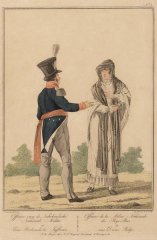
|
An officer of the National Guard and a Brabant lady. Unlike the soldiers and NCOs, the officers of the National Guard in 1815 all wore the prescribed shako of the North Dutch type because all officers were supposed to buy the prescribed uniform.
|
||
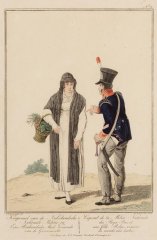
|
A corporal of the flank company of the National Guard and a Brabant girl. Presumably, the corporal is from the right flank company because of the red top. The jacket seems to have a fake pocket flap above the working pocket flap. The chevrons are French oblique style. The sabre tassel and cord are red, white and blue. Presumably the artist, when drawing from his sketches, was mistaken. This soldier is wearing the prescribed shako.
|
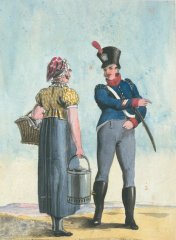
|
A corporal of grenadiers, Belgian Militia and a coffee seller. He wears a red pompom as insignia and wings with red/orange(?) ornamentation, the chevrons are placed diagonally on the French model, and only on the right sleeve. The boots seem to be a mistake by the artist. In the southern provinces the term "grenadier" was still in use.
|
||
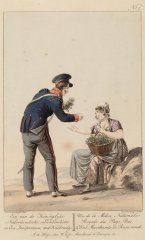
|
Flankeur of the National Guard and a radish seller: gray pants with orange trim over white gaiters, dark wings with white trim.
|
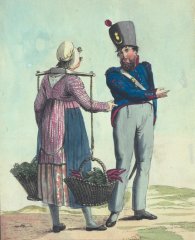
|
Sapper of the National Militia. The attire is more red than orange. The headgear is not clearly shown but is certainly the bear fur busby. It has no cords and the plume is a red instead of a white apple; a grenade and crescent(?) on the front, both in yellow metal. The sleeves close with a fly, just like the infantry of the Standing Army. Some suspect that this is actually a sapper of Infantry Battalion No. 8 (formerly 2nd Battalion Orange Legion).
|
||
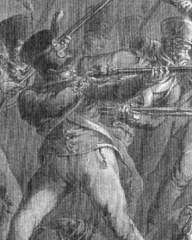
|
North Dutch infantry in action. Langendijk print of 1816. It is probably a representation of the Infantry Battalion in the forest of Bossu. Noteworthy are the French shako with "jugulaires", and epaulets of the French model. The soldiers of the National Guard appear dressed as prescribed. Click here for the entire print.
|
||||
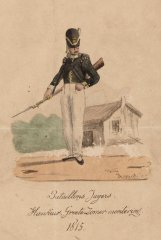
|
A southern Dutch jager-flanker, 1815. The lithograph is of a later date. Noteworthy is the colour of the bobble and catch cord, which appear yellow, and shako plate with number instead of a hunting horn. See also the picture of the death of Lt.Col. Coenegracht.
|
|
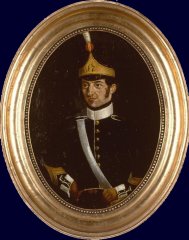
|
Portrait of an unknown sergeant-major of a fusilier company, 17th Infantry Detachment, 1820.
|
|
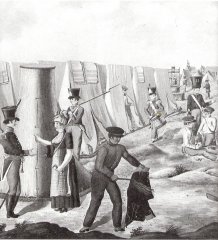
|
Bivouac of the 13th National Militia Battalion, 1820: The coats have laced flys, the shako is already the new model, but with the tin front plate. The sergeant has a black cover with the battalion number in white over his shako.
|
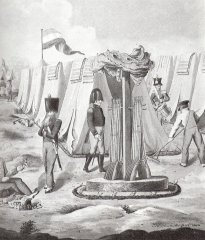
|
The Sapper bears a sapper's sabre, an officer of the staff (engineers?) passes by the stacked muskets. The soldiers generally wear the introduced northern Dutch model sleeved jacket with eight buttons and closed collar, the field cap (waarsachijnlijk) has a coloured band and piping. Although forbidden, gray pants are worn with white gaiters.
|
||
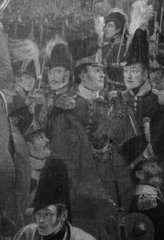
|
J.W. Pieneman, "de Slag bij Waterloo", 1824. The uniforms of the painting are from after 1815, as seen in this group of officers.
Click the image for the full picture.
|
|
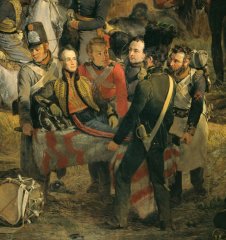
|
Detail of the painting by Pieneman, "De Slag bij Waterloo". The Prince of Orange is wounded, being carried away by a soldier and a sapper of the National Militia, and a Nassau grenadier.
|
|
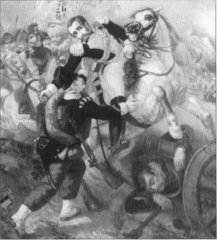
|
The death of Lt.Col. Coenegracht, commander of the 1st Carabineers Regiment, drawing by Th. Schaepman, 1852. The southern Dutch Jager-Flanker sergeant wearing the gray pants within the white gaiters, and a British 1812 shako with cover, his bandolier has a yellow metal hunting horn on the flap, the wings have a different decoration (probably a mistake by the artist), the overcoat is worn rolled over the left and he is armed with a hunting rifle.
|
|
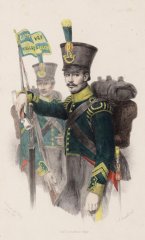
|
Portrait of Jhr. R. Baron van Breugel Douglas, Corporal of Volunteer Jagers Company, BJ16, coloured lithograph from 1866. This company consisted of students from the University of Franeker. Note the yellow piping on the pants. In the background is a fourier with the company's flag shown, the flag is preserved in the Fries Museum in Leeuwarden (note: the text on the reverse PRO - VINCIE - VRIES - LAND).
|